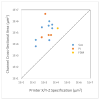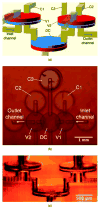Moving from millifluidic to truly microfluidic sub-100-μm cross-section 3D printed devices
- PMID: 28612085
- PMCID: PMC5542000
- DOI: 10.1007/s00216-017-0398-3
Moving from millifluidic to truly microfluidic sub-100-μm cross-section 3D printed devices
Abstract
Three-dimensional (3D) printing has generated considerable excitement in recent years regarding the extensive possibilities of this enabling technology. One area in which 3D printing has potential, not only for positive impact but also for substantial improvement, is microfluidics. To date many researchers have used 3D printers to make fluidic channels directed at point-of-care or lab-on-a-chip applications. Here, we look critically at the cross-sectional sizes of these 3D printed fluidic structures, classifying them as millifluidic (larger than 1 mm), sub-millifluidic (0.5-1.0 mm), large microfluidic (100-500 μm), or truly microfluidic (smaller than 100 μm). Additionally, we provide our prognosis for making 10-100-μm cross-section microfluidic features with custom-formulated resins and stereolithographic printers. Such 3D printed microfluidic devices for bioanalysis will accelerate research through designs that can be easily created and modified, allowing improved assays to be developed.
Keywords: Bioanalytical methods; Microfluidics/microfabrication; Separations/instrumentation.
Conflict of interest statement
The authors declare no conflicts.
Figures




Similar articles
-
3D Printed Microfluidics.Annu Rev Anal Chem (Palo Alto Calif). 2020 Jun 12;13(1):45-65. doi: 10.1146/annurev-anchem-091619-102649. Epub 2019 Dec 10. Annu Rev Anal Chem (Palo Alto Calif). 2020. PMID: 31821017 Free PMC article. Review.
-
A review of the recent achievements and future trends on 3D printed microfluidic devices for bioanalytical applications.Anal Chim Acta. 2024 Apr 22;1299:342429. doi: 10.1016/j.aca.2024.342429. Epub 2024 Feb 28. Anal Chim Acta. 2024. PMID: 38499426 Review.
-
Dynamic phase control with printing and fluidic materials' interaction by inkjet printing an RF sensor directly on a stereolithographic 3D printed microfluidic structure.Lab Chip. 2021 Nov 9;21(22):4364-4378. doi: 10.1039/d1lc00419k. Lab Chip. 2021. PMID: 34585708
-
Negligible-cost microfluidic device fabrication using 3D-printed interconnecting channel scaffolds.PLoS One. 2021 Feb 3;16(2):e0245206. doi: 10.1371/journal.pone.0245206. eCollection 2021. PLoS One. 2021. PMID: 33534849 Free PMC article.
-
Multi-Resin Masked Stereolithography (MSLA) 3D Printing for Rapid and Inexpensive Prototyping of Microfluidic Chips with Integrated Functional Components.Biosensors (Basel). 2022 Aug 17;12(8):652. doi: 10.3390/bios12080652. Biosensors (Basel). 2022. PMID: 36005047 Free PMC article.
Cited by
-
Impact of Beam Shape on Print Accuracy in Digital Light Processing Additive Manufacture.3D Print Addit Manuf. 2024 Apr 1;11(2):517-528. doi: 10.1089/3dp.2022.0193. Epub 2024 Apr 16. 3D Print Addit Manuf. 2024. PMID: 38689905 Free PMC article.
-
Direct 3D printed biocompatible microfluidics: assessment of human mesenchymal stem cell differentiation and cytotoxic drug screening in a dynamic culture system.J Nanobiotechnology. 2022 Dec 27;20(1):540. doi: 10.1186/s12951-022-01737-7. J Nanobiotechnology. 2022. PMID: 36575530 Free PMC article.
-
3D Printed Microfluidics.Annu Rev Anal Chem (Palo Alto Calif). 2020 Jun 12;13(1):45-65. doi: 10.1146/annurev-anchem-091619-102649. Epub 2019 Dec 10. Annu Rev Anal Chem (Palo Alto Calif). 2020. PMID: 31821017 Free PMC article. Review.
-
Microchip electrophoresis separation of a panel of preterm birth biomarkers.Electrophoresis. 2018 Sep;39(18):2300-2307. doi: 10.1002/elps.201800078. Epub 2018 Jun 1. Electrophoresis. 2018. PMID: 29683528 Free PMC article.
-
Projection Micro-Stereolithography to Manufacture a Biocompatible Micro-Optofluidic Device for Cell Concentration Monitoring.Polymers (Basel). 2023 Nov 19;15(22):4461. doi: 10.3390/polym15224461. Polymers (Basel). 2023. PMID: 38006185 Free PMC article.
References
-
- Amin R, Knowlton S, Hart A, Yenilmez B, Ghaderinezhad F, Katebifar S, Messina M, Khademhosseini A, Tasoglu S. 3D-printed microfluidic devices. Biofabrication. 2016;8:022001. - PubMed
-
- Lee KG, Park KJ, Seok S, Shin S, Kim DH, Park JY, Heo YS, Lee SJ, Lee TJ. 3D printed modules for integrated microfluidic devices. RSC Adv. 2014;4:32876–80.
MeSH terms
Grants and funding
LinkOut - more resources
Full Text Sources
Other Literature Sources
Miscellaneous

